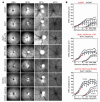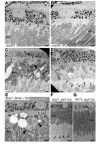Independent degeneration of photoreceptors and retinal pigment epithelium in conditional knockout mouse models of choroideremia
- PMID: 16410831
- PMCID: PMC1326146
- DOI: 10.1172/JCI26617
Independent degeneration of photoreceptors and retinal pigment epithelium in conditional knockout mouse models of choroideremia
Abstract
Choroideremia (CHM) is an X-linked degeneration of the retinal pigment epithelium (RPE), photoreceptors, and choroid, caused by loss of function of the CHM/REP1 gene. REP1 is involved in lipid modification (prenylation) of Rab GTPases, key regulators of intracellular vesicular transport and organelle dynamics. To study the pathogenesis of CHM and to develop a model for assessing gene therapy, we have created a conditional mouse knockout of the Chm gene. Heterozygous-null females exhibit characteristic hallmarks of CHM: progressive degeneration of the photoreceptors, patchy depigmentation of the RPE, and Rab prenylation defects. Using tamoxifen-inducible and tissue-specific Cre expression in combination with floxed Chm alleles, we show that CHM pathogenesis involves independently triggered degeneration of photoreceptors and the RPE, associated with different subsets of defective Rabs.
Figures






References
-
- Pacione LR, Szego MJ, Ikeda S, Nishina PM, McInnes RR. Progress toward understanding the genetic and biochemical mechanisms of inherited photoreceptor degenerations. Annu. Rev. Neurosci. 2003;26:657–700. - PubMed
-
- Stone EM, Sheffield VC, Hageman GS. Molecular genetics of age-related macular degeneration. Hum. Mol. Genet. 2001;10:2285–2292. - PubMed
-
- Strauss O. The retinal pigment epithelium in visual function. Physiol. Rev. 2005;85:845–881. - PubMed
-
- Heckenlively, J.R., and Bird, A.J. 1988. Choroideremia. In Retinitis pigmentosa. J.R. Heckenlively, editor. Lippincott Williams & Wilkins. Philadelphia, Pennsylvania, USA. 176–187.
-
- Cremers, F.P.M. 1995. Choroideremia. In The metabolic and molecular bases of inherited disease. C.B. Scriver, A.L. Beaudet, W.S. Sly, and D. Valle, editors. McGraw-Hill. New York, New York, USA. 4311–4324.
Publication types
MeSH terms
Substances
Grants and funding
LinkOut - more resources
Full Text Sources
Other Literature Sources
Molecular Biology Databases

